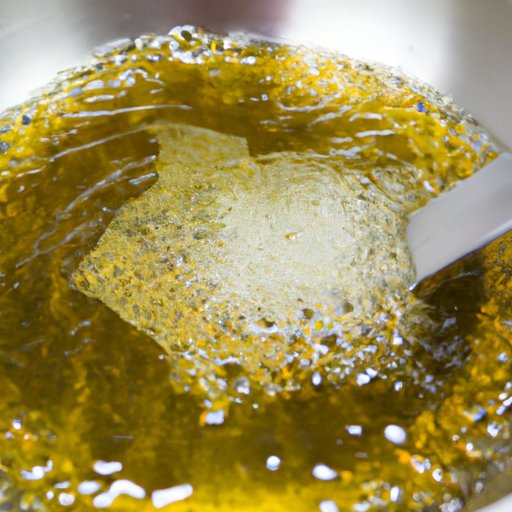Introduction
Frying in olive oil is a popular way to prepare food around the world. It is an easy method of cooking that can be used for a variety of dishes. But is it healthy? This article explores the pros and cons of frying with olive oil, as well as what you should know before making a decision about how to cook with this versatile ingredient.
Is Frying with Olive Oil a Healthy Choice?
The answer to this question depends on several factors. Frying in olive oil has both potential health benefits and risks. Let’s take a closer look at each:
Pros of Frying with Olive Oil
According to the World Health Organization (WHO), extra virgin olive oil contains antioxidants, including polyphenols, which may help reduce inflammation and protect against chronic diseases like heart disease and cancer.1 Studies have also found that olive oil can help lower LDL (“bad”) cholesterol levels, which can reduce the risk of stroke and heart attack.2
In addition, olive oil is a source of monounsaturated fatty acids, which are considered to be “good” fats. These fats can help promote healthy blood sugar levels and reduce the risk of type 2 diabetes.3
Cons of Frying with Olive Oil
Despite its potential health benefits, there are some drawbacks to frying in olive oil. For example, it has a relatively low smoke point – meaning it begins to break down and release toxic compounds when heated above 375°F.4 This means that if you fry at too high a temperature, you could be exposing yourself to harmful chemicals.
In addition, olive oil is high in calories – one tablespoon contains 119 calories.5 This means that if you’re using it to fry food, it could add up quickly. Finally, olive oil is not suitable for all types of cooking – it’s best suited for low-heat cooking methods like sautéing, baking, and roasting.6
What You Should Know About Frying in Olive Oil
When considering whether or not to fry in olive oil, it’s important to understand the nutritional content of the oil, as well as the different types of olive oil available. Here’s what you need to know:
Nutritional Content of Olive Oil
Extra virgin olive oil is rich in monounsaturated fatty acids, as well as polyphenols, which are antioxidants that can help reduce inflammation and protect against chronic diseases.7 It’s also a good source of vitamin E, which helps support the immune system and skin health.8
Different Types of Olive Oil
There are several types of olive oil available, and each has its own characteristics. Extra virgin olive oil is the highest quality and has a mild, fruity flavor. It’s best suited for low-heat cooking methods like baking, roasting, and sautéing.9
Light olive oil is a lighter version of extra virgin olive oil, and it has a higher smoke point, making it better suited for higher-heat cooking methods like frying.10 However, it does not contain as many beneficial nutrients as extra virgin olive oil.11
Temperature Considerations
It’s important to keep in mind that olive oil has a relatively low smoke point – 375°F.12 If you’re frying at a higher temperature than this, it’s best to use a different oil, such as peanut or canola oil.13
A Guide to Cooking with Olive Oil: Is Frying Healthy?
Frying in olive oil has both potential health benefits and risks. To make sure you get the most out of your cooking, here’s a guide to cooking with olive oil:
Choosing the Right Olive Oil
When choosing an olive oil, it’s important to select one that is labeled “extra virgin” or “light.” Extra virgin olive oil is the highest quality and has the most health benefits, while light olive oil has a higher smoke point and is better suited for higher-heat cooking methods.14
Tips for Frying with Olive Oil
When frying with olive oil, it’s important to keep the temperature below 375°F to avoid releasing toxic compounds.15 It’s also a good idea to measure the amount of oil you’re using – too much oil can lead to an unhealthy dish.16 Finally, make sure to store your olive oil in a cool, dark place to preserve its flavor and nutritional content.17
Alternatives to Frying
If you’re looking for a healthier way to cook with olive oil, consider trying other methods such as baking, roasting, or sautéing.18 These methods require less oil and can help preserve the nutritional content of the food.19
Conclusion
Frying in olive oil has both potential health benefits and risks. On the one hand, it’s a source of monounsaturated fatty acids and antioxidants, which can help reduce inflammation and protect against chronic diseases. On the other hand, it has a low smoke point and is high in calories, so it’s important to use it in moderation. When frying in olive oil, it’s important to choose the right type of oil, keep the temperature below 375°F, and measure the amount of oil used. For a healthier option, consider baking, roasting, or sautéing instead.
(Note: Is this article not meeting your expectations? Do you have knowledge or insights to share? Unlock new opportunities and expand your reach by joining our authors team. Click Registration to join us and share your expertise with our readers.)
